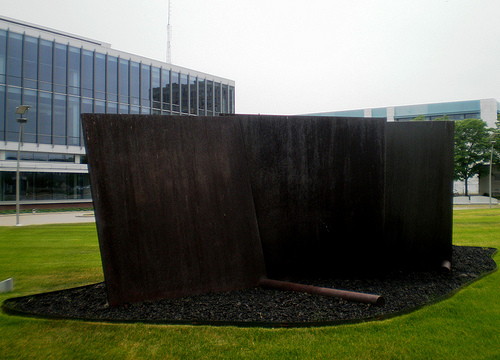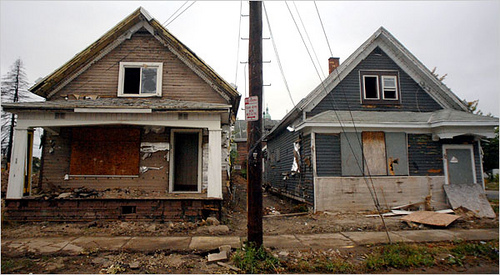Rusting & Rebirth
 In 1981 a controversy erupted over the installation at Federal Plaza in New York City over Tilted Arc a steel sculpture 120 feet long by 12 feet high. Eight years later, workers cut the sculpture into three pieces in the dead of night and carted it away as scrap. In many ways the work of this iconic sculpture’s work parallels, in an inversely proportional way the decline of what is lovingly called the American Rust Belt. Serra’s Tilted Arc cost $175,000 at the time. Serra was just rising to emergence in the contemporary art scene and was an outspoken figure, representing the paradigm of ‘working class’ emergence as befitting the American dream. Today, Richard Serra’s work requires a ‘deposit’ of $1m and costs at minimum, if he chooses your site as worthy, upwards of $3m.
In 1981 a controversy erupted over the installation at Federal Plaza in New York City over Tilted Arc a steel sculpture 120 feet long by 12 feet high. Eight years later, workers cut the sculpture into three pieces in the dead of night and carted it away as scrap. In many ways the work of this iconic sculpture’s work parallels, in an inversely proportional way the decline of what is lovingly called the American Rust Belt. Serra’s Tilted Arc cost $175,000 at the time. Serra was just rising to emergence in the contemporary art scene and was an outspoken figure, representing the paradigm of ‘working class’ emergence as befitting the American dream. Today, Richard Serra’s work requires a ‘deposit’ of $1m and costs at minimum, if he chooses your site as worthy, upwards of $3m.
The documentary Detropia highlights this decline of the very manufacturing base that gave Serra his early know-how in manipulating steel. It examines the sharp decline since 1950 in the city of Detroit and its huge manufacturing base, in their case automobiles. Filmed from the perspective of local inhabitants who have a stake in the city, the film poignantly reveals the human side to the American decline in manufacturing and in turn, the downfall of the Rust Belt. [vimeo http://www.vimeo.com/45929284 w=500&h=281]
DETROPIA Trailer from Loki Films on Vimeo.
I grew up just 40 minutes east of Buffalo, NY. In the 1970’s Buffalo was a big flourishing city with a manufacturing base built on the Bethlehem Steel mill in Lackawanna, General Motors and Standard Milling. It was also just south of the world famous Niagara Falls, which provided robust summer tourism to the area. Unfortunately by 1971 Buffalo’s population, much like Detroit, Cleveland and Pittsburgh was already experiencing a downward trend. As of the 2010 census Buffalo’s population stands at 261,000 almost precisely 50% of it’s high point in 1950. 1971 saw the announcement that Bethlehem Steel would lay off 50% of its workforce due to competition from Japan and Germany. By the end of the decade that number was mirrored by other steel mills, General Motors and the milling operations.  Combine that data with the superfund site discovery in 1978 called the Love Canal and it is easy to see why Buffalo’s population has declined so dramatically. In the last ten years alone, Buffalo’s population has declined 10% while housing prices plummet along with the rise in crime and unemployment.
Combine that data with the superfund site discovery in 1978 called the Love Canal and it is easy to see why Buffalo’s population has declined so dramatically. In the last ten years alone, Buffalo’s population has declined 10% while housing prices plummet along with the rise in crime and unemployment.
Richard Serra bounced back nicely from his defeat by a federal courthouse in 1989. He has seen the expansion of America’s most important modern art museum, the Museum of Modern Art in NY with planning that specifically took into account the promise of his retrospective. In many ways this is a cruel irony. I in no way am diminishing Serra’s work or his standing as one of the greatest 20th century sculptors. Rather I am pointing out that the artist that brings us most of our global cultural recognition works in a material that harkens back to an era when American dominated the international manufacturing landscape. Now we dismantle Detroit’s ruins, angling toward an ‘urban farmscape’ so the scrap that is salvaged by the destitute there can be shipped to China and reprocessed into junk we don’t need. The dominant grandeur that is a Richard Serra sculpture no longer lives in the cities that made that expression possible.
There is a glimmer of hope in Detropia, where young artists are relocating to Detroit in order to find cheap rents and lots of space to experiment and create. Detroit has always been a hot bed of creativity, especially in music with Motown and Techno. If there is an American spirit left it could very likely find its home in the rebirth of Detroit. Add this to the fact that for better or worse the planet is getting hotter and the southern states that seemed cozy to baby boomers will not be so appealing to future generations. Finally, if we can sideline petty politics long enough, we can find Detroit may have a huge potential for reinventing our economy through renewable technologies. Little known is that Detroit contains 1400 acres of abandoned salt mines below its surface that could be a future containment vessel for carbon sequestered or hydrogen storage. Serra, a child of the depression, understands how learning from decline and war can produce great art. Lets hope it does the same for the young artists moving to the Rust Belt.
As the film points out, where Detroit goes, so goes America. We need to be weary of globalization, the emergence of the Chinese economy and our destruction of both unions and the middle class. We have added over 1 million millionaires since Obama took office while production of automobiles continues to move to China and Mexico. If you think this is a matter of pure labor costs as some would like you to believe and overpriced union demands, think again. In 2010 Germany produced 5.5 million automobiles to America’s 2.7 million. The average German auto worker made $67.14 per hour (including benefits - and keep in mind they have socialized medicine in Germany) while U.S. auto workers were paid $33.77 an hour. BMW, Daimler and Volkswagen are some of the most profitable auto manufacturers in the world. Last year, Germany is fourth globally in manufacturing as a percent of GDP and fourth overall in total manufacturing production. China is now number one, with the U.S. as number two, however we’re 7th and declining as a percentage of GDP and Germany’s population is a mere 80 million compared to our robust 300 million and China’s enormous 1.1bn. All this from a country that was largely razed to the ground 60 years ago. As the head of the local autoworker’s union says in Detropia, “a service-based nation is weak.”
I don’t mean to downplay the complexity of the problem which involves race, the military industrial complex, a shift away from limitations on banking and wealth that FDR put into place and Reagan through Clinton dismantled, but we certainly have the means. I hope Detroit becomes a parable for emergence, decline and rebirth rather than just decline.
Addendum: This was posted to Co.Design daily about a watch company that is repurposing Detroit space and making high end leather goods and watches called Shinola. "After looking at a number of cities, the team decided to establish the company in Detroit, the former manufacturing powerhouse and something of an American throwback itself. It’s a tidy fit that, like the Shinola name, Detroit too is in the early stages of a 21st-century reinvention."